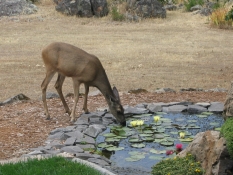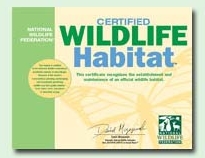Why create a National Wildlife Federation Certified Wildlife Habitat? There are several, very good reasons.
The first and most important reason is that it is fun for the entire family! Imagine bringing wildlife right into your own backyard and watching nature unfold before your very eyes.
One of the things I love most about my home is being able to look out my window and see, not only a huge number of birds and bird species, but also the other wildlife that we have attracted by having a Certified Wildlife Habitat.

The first thing you will notice when you have a waterfall, pond or fountain for example, is that you will have more birds visiting your home because birds can’t resist moving water. You will also attract frogs, dragonflies, and mammals local to your area.
The next aspect of a Certified Wildlife Habitat would be food. When talking about birds, the first thing that comes to mind is bird feeders of course. But this is not the only source of food for our birds. The biggest source of food should be native plants like trees, shrubs, berries and native grasses. Our bird feeders will supplement food found in the natural habitat.
The same philosophy applies to cover and places for wildlife to raise their young. The best way to provide cover is to have plenty of native vegetation available where wildlife can find protection. Using native vegetation means very little maintenance, if any, is needed, saving you time and money.
In addition to native vegetation, supplying birdhouses or nest boxes is an excellent way to increase the bird population in your area. Birdhouses can be made easily and inexpensively with good birdhouse plans or you can simply buy well made birdhouses to bring birdwatching to your backyard.
Sustainable gardening is also important in creating a wildlife habitat. This would include techniques you can use to conserve resources. Once again, planting native species, mulching and reducing lawn areas are a few excellent ways to start.
To see what you can do to create a Certified Wildlife Habitat, go to the National Wildlife Federation website and read all about it. It all starts with us. If we all do what we can to preserve habitat around our homes, we can help save natural habitat for future generations.










Comments on this entry are closed.
It is amazing the difference a pool or fountain makes in a garden. I built a huge waterfall ending in pool years ago and alsmost immediately there were more birds, dragonflies and frogs around. 🙂
The NWF “vanity sign” doesn’t attract one bird or animal! We decided to spend the hefty $20 NWF registration fee plus the $25 (ugly, cheap sign) or $90 & $19 S+H fee (deluxe, expensive sign) for more food and habitat development for our already “critter friendly” yard.
Our human visitors need no NWF sign to know our rural home along the Scenic Designated section of the Allegheny River is a special, safe haven for ALL creatures – big and small. It is a stunning habitat that doesn’t lend itself to signs!
Maybe like you, we have already spent many thousands of dollars and countless hours through the years to make our home a haven for wildlife and our reward is the wildlife – not bragging rights to buy a sign and hang it up for all to see. I don’t remember getting any help through the years from the NWF.
Still, if you want vanity signs to hang – contact the NWF. But they are just another 501-c3 with an angle and an office staff somewhere. (I wonder how many bird feeders they keep full?) You want habitat info? It is all over the web for free. Love animals? Give to the Humane Society or an Animal Rehab Organization. Then go and visit to see the people in the trenches taking care of wonderful wildlife IN YOUR COMMUNITY.
By all means take care of your habitat – not another national charity. Do you know what percent of NWF take is administrative? What do they do with their funds that really helps wildlife? Finally, do you know the legal ramifications of getting “designated”? You had better find out!
@Jim it appears that you have a rather negative view of the National Wildlife Federation, even though they have done much good work for the environment including fighting climate change, protecting and restoring wildlife habitat and connecting people with nature.
Obviously no one needs a sign to show other people that they are an environmental conservationist. Our actions speak for themselves and the wildlife we protect.
I also give to my favorite local animal rehabilitation center, the . I hope that most people give to there local rehabers also.
The NWF uses 7.5% of its budget for administrative expenses. My complaint would be that it spends 14.2% in fund raising expenses, mostly for mailings and “gifts” that are not needed for folks actually interested in donating to a good cause. You can see the report here and their annual report for 2008 here.
I believe that they are a good organization, doing much good work toward animal and habitat preservation, public education on the environment and helping to fight climate change.
I don’t believe being designated as a “Certified Wildlife Habitat” by the NWF has any legal ramifications whatsoever. If you have any knowledge to the contrary, please enlighten me and my readers.
Thanks for your comment